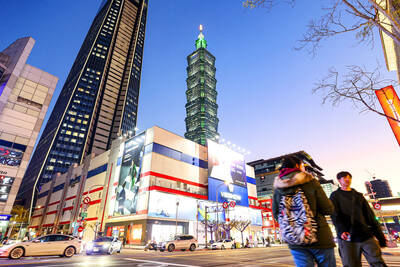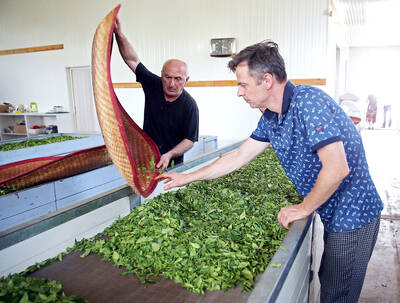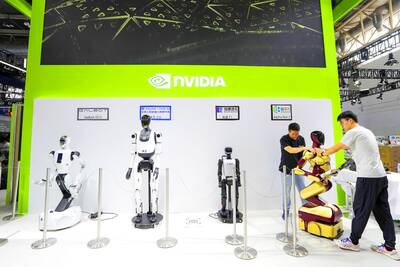Christian, aged 10, has 20 pairs of high-end sneakers in his closet at his home in the suburbs of New York.
Maxance, who just turned 14, asked his parents for an US$800 pair of Adidas AG shoes for his birthday. He did not get them.
“We live in a world where sneakers are basically works of art,” the teenager said.

Photo: AFP
The world is also one in which luxury sneakers — often limited-edition collaborations between the big names in sportswear and fashion labels, rappers or famous athletes — have become a coveted accessory for everyone from tween boys to middle-aged men.
Some pairs fetch tens of thousands of dollars — the super-rare Derek Jeter Air Jordan 11, named for the New York Yankees superstar — were going for about US$50,000 in the past few weeks. Only five pairs were released.
Such shoes are bought second or thirdhand, mainly on the Internet, but also in chic boutiques or pop-up stores, packaged in plastic wrap to protect them.
New York is one of the capitals of this flourishing high-end sneaker culture, although the trade in trainers is hardly new. It began in the 1990s — when Nike Inc made it big with the first Air Jordans, made for legendary basketball star Michael Jordan, which quickly became must-have collector’s items.
Then in the 2000s, the market grew as the Internet boomed, especially on auction sites like eBay.
Today, boosted by celebrities, social media influencers and the mainstream influence of rap culture, the sneaker biz has gone global. It is particularly big in the US, Europe and Asia.
Since 2016, it even has its own “stock exchange” — Web site StockX.
The actual size of the luxury sneaker market is hard to estimate, but one thing is clear — “that market has had nice growth,” NPD Group Inc sports industry analyst Matt Powell said.
Even if it is centered on a few key industry players, the market is fed by a mass of small-time vendors — many of them sneaker addicts themselves looking for a quick way to make extra cash.
“Estimates of the resale market is that it’s at US$1 billion,” Powell said, adding that it is still a “pretty small sliver” of the overall athletic shoe market, which last year hit US$38 billion in the US and US$100 billion worldwide.
However, for John McPheters, president and cofounder of Stadium Goods, a mainly online business that opened what has become one of New York’s most popular sneaker stores in Soho in late 2015, these estimates are way too low.
Stadium Goods last year sold more than US$100 million in shoes, McPheters said.
Sales have at least doubled this year, in what he said is a healthier market now that certificates of authenticity have become the norm.
“What we are doing today is really just scratching the surface of what is going to be an even bigger business in the years to come,” the 38-year-old said.
The future plans of McPheters and Stadium Goods are a good indication of the luxury sneaker market’s potential and worldwide appeal.
While Internet sales account for 90 percent of the firm’s total for now, it plans to open several more actual stores in the US and abroad.
China is its largest market outside the US, followed by Britain and Canada, McPheters said.
Thanks to a partnership with Britain-based online fashion platform Farfetch, Stadium Goods is hoping to soon break into the Russian market.
Matt Troisi, 29, is a regular customer at Stadium Goods — he owns about 300 pairs of sneakers — and an experienced buyer and seller online. He is convinced the market is huge and about to explode.
Troisi said he earns US$25,000 to US$35,000 per year in the sneaker trade — about half of what he makes as a manager for restaurant conglomerate Tao Group, where he rubs shoulders with celebrities who help him get access to limited-edition treasures.
“Men — sometimes we don’t have the best fashion. We don’t really know what the cool stuff is,” Troisi said.
“We can wear all black and have no style whatsoever in clothing and just throw on a cool pair of sneakers and that’s your outfit,” he added with a laugh.
On his feet? A pair of Nike sneakers marking the 1969 lunar landing that are worth about US$1,000.
One key to the future growth of the luxury kicks business will be to attract more women, McPheters said.
“That’s one of the problems in the industry, one of the areas brands need to focus on,” he said.
“For a long time, brands have tried to entice female sneakerheads with pink laces and ‘feminine’ colors, while in reality, women want the exact same products as men do,” he added. “Over the next few months, we’re working on some innovative ways to better present our products with women in mind.”

UNCERTAINTIES: Exports surged 34.1% and private investment grew 7.03% to outpace expectations in the first half, although US tariffs could stall momentum The Chung-Hua Institution for Economic Research (CIER, 中華經濟研究院) yesterday raised its GDP growth forecast to 3.05 percent this year on a robust first-half performance, but warned that US tariff threats and external uncertainty could stall momentum in the second half of the year. “The first half proved exceptionally strong, allowing room for optimism,” CIER president Lien Hsien-ming (連賢明) said. “But the growth momentum may slow moving forward due to US tariffs.” The tariff threat poses definite downside risks, although the scale of the impact remains unclear given the unpredictability of US President Donald Trump’s policies, Lien said. Despite the headwinds, Taiwan is likely

When Lika Megreladze was a child, life in her native western Georgian region of Guria revolved around tea. Her mother worked for decades as a scientist at the Soviet Union’s Institute of Tea and Subtropical Crops in the village of Anaseuli, Georgia, perfecting cultivation methods for a Georgian tea industry that supplied the bulk of the vast communist state’s brews. “When I was a child, this was only my mum’s workplace. Only later I realized that it was something big,” she said. Now, the institute lies abandoned. Yellowed papers are strewn around its decaying corridors, and a statue of Soviet founder Vladimir Lenin

UNIFYING OPPOSITION: Numerous companies have registered complaints over the potential levies, bringing together rival automakers in voicing their reservations US President Donald Trump is readying plans for industry-specific tariffs to kick in alongside his country-by-country duties in two weeks, ramping up his push to reshape the US’ standing in the global trading system by penalizing purchases from abroad. Administration officials could release details of Trump’s planned 50 percent duty on copper in the days before they are set to take effect on Friday next week, a person familiar with the matter said. That is the same date Trump’s “reciprocal” levies on products from more than 100 nations are slated to begin. Trump on Tuesday said that he is likely to impose tariffs

READY TO BUY: Shortly after Nvidia announced the approval, Chinese firms scrambled to order the H20 GPUs, which the company must send to the US government for approval Nvidia Corp chief executive officer Jensen Huang (黃仁勳) late on Monday said the technology giant has won approval from US President Donald Trump’s administration to sell its advanced H20 graphics processing units (GPUs) used to develop artificial intelligence (AI) to China. The news came in a company blog post late on Monday and Huang also spoke about the coup on China’s state-run China Global Television Network in remarks shown on X. “The US government has assured Nvidia that licenses will be granted, and Nvidia hopes to start deliveries soon,” the post said. “Today, I’m announcing that the US government has approved for us